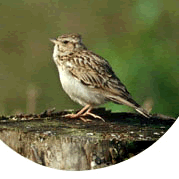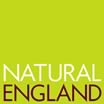 |
|||||||||
|
|||||||||||||||||||
|
|
Boom in Woodlarks Prompts Return
to Farmland Woodlarks are returning to breed on England’s farmland in greater numbers than at any time in the last 40 years.
A new national survey has found woodlark numbers in the UK have risen by 89 per cent in the last 10 years. The rise has been driven by work to provide suitable habitat – improvements to the size and condition of lowland heaths and good management of forestry plantations. Increasing numbers of the birds now appear to be moving on to farms to breed, with many nesting on set-aside land. There are fears however that the imminent loss of set-aside, because of changes in the way Europe pays its farmers, could limit the woodlark's spread unless suitable alternatives are provided. The results of the survey, carried out by the British Trust for Ornithology, Natural England, RSPB and the Forestry Commission (England), show an estimated 3,084 breeding pairs of woodlark, compared with 1,633 pairs in 1997 and the low point of just 241 pairs in 1986. Traditionally a bird of heathland, farmland and more recently forest plantations, the woodlark was red-listed as a species of conservation concern in the 1980s because of a drastic decline in its range over the preceding 20 years. Much of the decline coincided with the loss of traditional, mixed farmland in the South West and Wales, along with the loss of heathland habitat throughout the UK. This latest survey shows how set-aside has tempted a proportion of the UK’s burgeoning woodlark population to return to farmland. Simon Wotton, research biologist at the RSPB, said: “About 21 per cent of the birds we surveyed were on farmland and other grassland habitats, of which about 7 per cent was set-aside. It seems woodlarks are moving on to this land from nearby heaths and from forest plantations.” Natural England’s senior ornithologist, Allan Drewitt, added: “It is encouraging to see such a dramatic increase in the numbers and breeding range of woodlarks. This is largely the result of improvements to their lowland heathland habitats by conservation bodies including Natural England, the RSPB and local wildlife trusts, and the efforts of the Forestry Commission in providing and maintaining suitable nesting areas in their plantations. “The £25m Heritage Lottery funding of Tomorrow’s Heathland Heritage has done a lot to help heathland species like the woodlark. “We must now increase our efforts to restore and manage lowland heaths for the woodlark and other wildlife, and also ensure that the management of forestry plantations continues to provide breeding habitats."
|
||||||||||||||||||

|
|
||||||||||||||||||
| home | agri-services | pedigree
pen | news | dairy | beef | machinery property | organisations | site map |
|||||||||||||||||||

